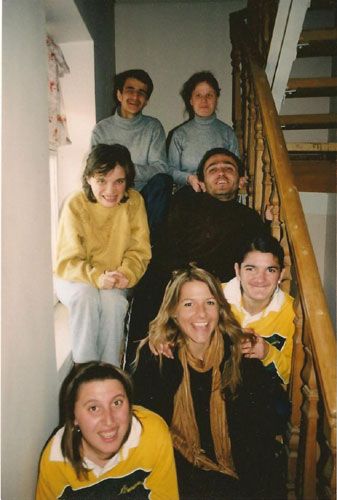Service in the Peace Corps
Published 3:21 pm Thursday, April 22, 2010

- Submitted photos Bridget Brown helped create Warm Hearths after she served as a Peace Corps volunteer in Armenia. Warm Hearths is a home for the disabled. - Submitted photos
ENTERPRISE – It’s no secret that Wallowa County residents are community minded. When tragedy hits, locally or globally, dinners, pie auctions and fundraisers are set in action.
Among many of the county’s community leaders are former Peace Corps volunteers who share the compassion and skill sets acquired from working abroad in developing nations.
Marya Nowakowski graduated from Washington State University with a master’s in plant ecology and was working for the Forest Service in
La Grande when she joined the Peace Corps. She began her training in August 1987 and was assigned to a dry part of the Dominican Republic to work in reforestation.
“The deforestation is worse in Haiti, but there has still been a great deal of it in the Dominican Republic since World War II,” Nowakowski said.
Dominican farmers grow food and cash crops, she said. When she was in the Dominican Republic, wood lots were new. Because of the deforestation, woodcutting had been prohibited by federal law. One of the Peace Corps’ successes, she said, was convincing the government to make an exception to that law and allow permission to cut trees on the tree farms.
Farmers grow trees for building materials and for charcoal, the main source of cooking fuel in the Dominican Republic. Nowakowski said the local Catholic Church was involved in the reforestation program by finding Peace Corps volunteer foresters, connecting them with farmers with wood lots, and providing funding for tree planting. The church also bought the seeds to start a nursery.
Since Nowakowski was working through the local Catholic Church as well as with the Peace Corps, it helped her acceptance among the local people.
The main tree species Nowakowski worked with were Neem, a species from India that is a natural insecticide that protects the other crops, Leucaena and Tamarindo, which produces the fruit tamarind used in many Caribbean dishes and drinks.
She returned to the Dominican Republic a few years after her tour and could see the success of the work she had done.
“Terraces were forming and feedback from the farmers was that they were pretty happy with the results.”
Though trained in science, through the Peace Corps experience Nowakowski developed more of an interest in people.
“At the end I was thinking I wanted to work with people when I came back,” she said.
When she returned to the U.S., Nowakowski lived in Enterprise for a while to re-group for a few months and apply for jobs. She was hired as a Peace Corps recruiter in Seattle, a position she had some definite ideas about.
“I realized a lot of people seemed clueless about being professional. Many of the young people in the Peace Corps have a more relaxed attitude than I did. As a recruiter I could help find people with more professional attitudes,” she said.
Another attitude issue Nowakowski discovered among some of the other volunteers was their problem-solving skills.
“What worked in San Francisco won’t work in the Dominican Republic,” she said.
As a recruiter she could also encourage recruits to understand the need to adapt their skills to a new environment.
Today Nowakowski is one of the most visible and busiest women in Enterprise. She works for the city and is heavily involved, at present, in revitalizing Wallowa County’s capital city.
Bridget Brown attended Enterprise High School, was on the Chief Joseph Days rodeo court and studied religion at Pepperdine University. Having enough of the comfortable life, she joined the Peace Corps in 2001 and was assigned to Armenia. It was the toughest two years of her life, Brown said.
As a former Soviet Block country, Armenia is still struggling without the financial support of Russia.
“The country has no natural resources,” Brown said. “Armenia is second to Israel in receiving U.S. aid.”
Brown joined the Peace Corps to work with disabled children. When she arrived in Armenia she was assigned to a boarding school that supposedly served tuberculosis-positive children. The students, in reality, were regular kids getting meals and boarding. Brown worked with the school on and off during her time in Armenia, but went in search of truly disabled children to serve.
When Brown discovered the children she was assigned weren’t disabled, she sought and received a list from the Red Cross of eight kids with disabilities. She visited children with post traumatic stress disorder, children who grew up around land mines in a country that had recently been at war.
The children suffering from PTSD needed psychiatry, something they don’t have in Armenia. Their issues were way beyond the scope of disabled.
The word got out about the work Brown was trying to do. She then received a list of 200 registered cases from the government of documented disabilities and started knocking on doors.
When she completed documenting her findings she wrote a grant to the Peace Corps’ Small Project Assistance program and received $5,000. With this she started a family center for kids with disabilities. To this day, parents still run the facility.
During the process of looking for disabled children, Brown found an orphanage/vocational school. Severely disabled infants are killed by doctors when they are born, Brown said. Children who live with disabilities are often placed in orphanages, but they aren’t always orphans. They have parents who have rejected them because of their disability. This mindset made it difficult, initially, for her to even find the population she wanted to serve.
At the orphanage she worked with 20 of the most vulnerable students teaching health, hygiene and independent living skills. She helped them make greeting cards. They tried to sell them in local stores, but Brown said that the process of creating the cards was more important than selling the product.
After Brown returned to the U.S. her replacement e-mailed her that eight of the orphanage’s students were being released. When children become too old for orphanages they are placed in an institution known as a “graveyard.” Disabled adults placed in institutions often starve or freeze to death. There is no glass in the windows, no blankets and few mattresses, Brown said.
This situation was a call to action and the genesis of Warm Hearths. Brown raised money, largely from Wallowa County, and flew back to Armenia to buy a house for the eight displaced students. Brown credits friends and family in Wallowa County for making Warm Hearths a reality. The home is still in existence, housing adults with disabilities. Brown continues to serve on its board and returns every other year to Armenia.
Clem and Jean Falbo of Joseph served in Zimbabwe for the Peace Corps from the fall of 1999 to winter 2001. Their work was cut short when the Peace Corps pulled out of the country due to increasing violence.
“Zimbabwe became so troubled that the dictator, Mugabe, didn’t want outsiders to see what was going on,” Jean Falbo said.
They were given four days to evacuate in early 2001.
When they arrived in 1999 the Falbos began teaching science and math in rural schools. They worked in open air classrooms with no electricity and with very old textbooks. What textbooks remained were from pre-revolutionary rule, outdated, and tattered.
The transfer of power from white rule to black was negotiated in the 1980s. Since then it’s as if education exists in a time capsule.
Clem said, “The math books were not useful, so I would write problems on the chalkboard.”
Jean taught from “vintage” 1980 science textbooks. The elementary students were graded on a national exam to move up to the equivalent of the junior high level. To give the students a broader perspective of modern science, she would teach them about topics such as the deciphering of DNA molecules when they had completed their work.
“I told them not to take notes because it would not be on the exam,” she said.
Early in Mugabe’s regime school was free for all children. The completely white schools were changed to black schools overnight. By the late-1990s many schools charged tuition and services were becoming less available.
When the government began invading the white farms, killing farmers and taking over the operations, the Falbos were moved to an urban area.
“There are two Zimbabwes,” Clem said.
The rural areas have high rates of illiteracy. They have held onto what the Falbos call the Victorian “prissiness” of the colonial days. The women wear clothes that cover most of their bodies. Before colonial times they were an iron age culture and wore leather skins and feathers.
The urban areas are very western with TVs, cell phones and cars. They dress in western clothing and have jobs as opposed to a subsistence lifestyle.
Zimbabwe, especially in rural areas, still has the influence of the chiefs, Clem said. They serve in positions similar to county commissioners. Though the chiefs don’t have the same power they had, they do get involved with conflict resolutions among families.
Added into the mix of pre-colonial customs, hold-over colonial customs and post-revolutionary lifestyles is that one-third of adults in the country have HIV/AIDS, Jean said. Since there was no availability to anti-retroviral medication, an HIV diagnosis gave a patient a year and a half to live. Funerals were a constant part of the ebb and flow of life while the Falbos served in Zimbabwe.
The first year in the Peace Corps the Falbos said they spent figuring out how to live in Zimbabwe. The second year was about coping and trying to be the most effective they could. They agreed that the hardest part was coming home.
After returning home, the Falbos continued their dedication to Zimbabwe by funding the boarding school educations for a handful of students.




